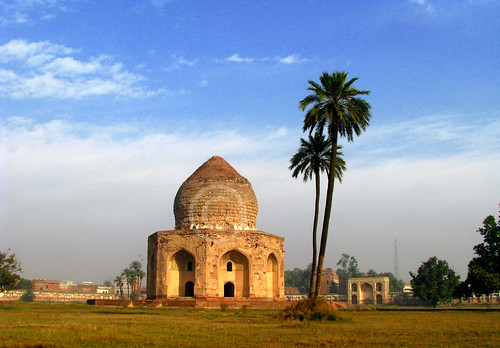Quaid’s Tomb:-
Mazar-e-Quaid refers to the mausoleum of the founder of Pakistan, Muhammad Ali Jinnah. It is an iconic symbol of Karachi throughout the world. The mausoleum, situated at the heart of the city, was completed in 1960s.It is made up of white marbles with curved Moorish arches and copper grills reset on an elevated 54 square meters platform. The cool inner sanctum reflects the green of a four-tiered crystal chandelier gifted by the people of China.


Allama Iqbal’s Tomb:-
Outside the Badshahi Mosque (Lahore), near its steps, lies the tomb of Allama Iqbal, the poet- philosopher of the East. The mausoleum is a mixture of Afghan and Moonsh styles of architecture and is constructed entirely of red sandstone.


Jahangir’s Tomb:-
The tomb of the fourth great Mughal Emperor Jahangir lies 5 km north-west of Lahore across the River Ravi. It has a majestic structure made up of red sand-stone and marble. The outer entrance to the tomb opens out into a court-yard which was used as a caravan Serai during Mughal times. An entrance to the right leads into a Mughal Garden with exact geometrical patterns balancing each side. The marble tomb is approached from four corridors leading from the Garden. The marble grave is elaborately inlaid with floral designs and the 99 Attributes of Allah are inscribed on its two sides. On the top is a verse from the Holy Quran. The tomb was built by Queen Noor Jehan and the Emperor’s son Shah-Jehan around 1637 A.D.


Sohni’s Tomb:-
The Tomb of Sohni in Shahdapur city, Sindh is 75 km from (Hyderabad). According to the legend, the bodies of Sohni Mahiwal were recovered from river Indus near Shahdapur and hence are buried there.

Noor Jahan’s Tomb:-
The Empress Noor Jahan, "Light of the world", was the only Empress whose name appeared on the coins of the Mughal empire. She was buried in 1645 A.D. at Shahdara (Lahore) outside Jehangir’s mausoleum across the railway line.Her tomb once had a marble cenotaph which she had built herself during her life time. After the decline of Mughal rule, the tomb suffered extensive damages along with her husband’s tomb at the hands of Sikh marauders when they gained power during the early part of nineteenth century. Both were stripped of most of its original beauty and splendour. All treasures and tiles, it is said, were carted off to decorate the Golden Temple at Amritsar India.

Asif Khan’s Tomb:-
The tomb of Asif Khan, Jahangir’s brother-in-law and father of Shah Jahan’s beloved Queen Arjumand Bano,is on the opposite (west) side of the Akbari Sarai.A passage on the left of handsome red sandstone mosque that stands opposite the gate of the Jahangir’s Tomb, leads to Asif khan’s Tomb.

Mazar-e-Quaid refers to the mausoleum of the founder of Pakistan, Muhammad Ali Jinnah. It is an iconic symbol of Karachi throughout the world. The mausoleum, situated at the heart of the city, was completed in 1960s.It is made up of white marbles with curved Moorish arches and copper grills reset on an elevated 54 square meters platform. The cool inner sanctum reflects the green of a four-tiered crystal chandelier gifted by the people of China.


Allama Iqbal’s Tomb:-
Outside the Badshahi Mosque (Lahore), near its steps, lies the tomb of Allama Iqbal, the poet- philosopher of the East. The mausoleum is a mixture of Afghan and Moonsh styles of architecture and is constructed entirely of red sandstone.


Jahangir’s Tomb:-
The tomb of the fourth great Mughal Emperor Jahangir lies 5 km north-west of Lahore across the River Ravi. It has a majestic structure made up of red sand-stone and marble. The outer entrance to the tomb opens out into a court-yard which was used as a caravan Serai during Mughal times. An entrance to the right leads into a Mughal Garden with exact geometrical patterns balancing each side. The marble tomb is approached from four corridors leading from the Garden. The marble grave is elaborately inlaid with floral designs and the 99 Attributes of Allah are inscribed on its two sides. On the top is a verse from the Holy Quran. The tomb was built by Queen Noor Jehan and the Emperor’s son Shah-Jehan around 1637 A.D.


Sohni’s Tomb:-
The Tomb of Sohni in Shahdapur city, Sindh is 75 km from (Hyderabad). According to the legend, the bodies of Sohni Mahiwal were recovered from river Indus near Shahdapur and hence are buried there.

Noor Jahan’s Tomb:-
The Empress Noor Jahan, "Light of the world", was the only Empress whose name appeared on the coins of the Mughal empire. She was buried in 1645 A.D. at Shahdara (Lahore) outside Jehangir’s mausoleum across the railway line.Her tomb once had a marble cenotaph which she had built herself during her life time. After the decline of Mughal rule, the tomb suffered extensive damages along with her husband’s tomb at the hands of Sikh marauders when they gained power during the early part of nineteenth century. Both were stripped of most of its original beauty and splendour. All treasures and tiles, it is said, were carted off to decorate the Golden Temple at Amritsar India.

Asif Khan’s Tomb:-
The tomb of Asif Khan, Jahangir’s brother-in-law and father of Shah Jahan’s beloved Queen Arjumand Bano,is on the opposite (west) side of the Akbari Sarai.A passage on the left of handsome red sandstone mosque that stands opposite the gate of the Jahangir’s Tomb, leads to Asif khan’s Tomb.






No comments:
Post a Comment